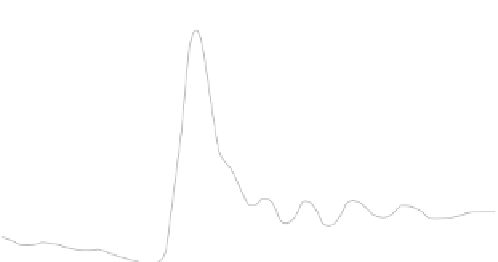Environmental Engineering Reference
In-Depth Information
100
90
80
70
60
50
40
30
20
10
0
-60
HSD
JB20
JB50
JB100
-50
-40
-30
-20 -10
Crank angle (degree)
0
10
20
30
40
50
60
FIGure 14.6
Pressure versus crank angle for diesel, JB, and JBB at full engine load. (From Sahoo, P.K. and
Das, L.M.,
Fuel,
88, 994-999, 2009b.)
100
Diesel
JB20
JB50
JB100
80
60
40
20
0
-40
-20
0
20
40
-20
Crank angle (degree)
FIGure 14.7
Heat release rate for diesel, JB, and JBB at full engine load. (From Sahoo, P.K. and Das, L.M.,
Fuel
, 88, 994-999, 2009b.)
Pradeep and Sharma (2007) analyzed the combustion parameters of a 3.7-kW diesel engine using
JB with and without exhaust gas recirculation (EGR). No significant deterioration in cylinder pres-
sure was observed for JB with 15% EGR and without EGR. The peak cylinder pressure was found
to be 52.5, 53.9, and 53 bar for diesel, JB, and JB with 15% EGR, respectively. The rate of pressure
rise at full load was found to be 5.8 and 6.2 bar/deg for diesel and JB, respectively, as compared with
5.7 bar/deg for JB with 15% EGR.
14.5.1.2 heat release rate
While studying the combustion characteristics of a 7.46-kW diesel engine when operated with JB,
JBB, and diesel, Sivprakasam and Saravanan (2007) reported that heat release rate was maximum
for the B20 blend [80 kJ/m
3
°crank angle (CA)], followed by diesel (75 kJ/m
3
°CA). The heat release
rate for JB, JBB, and diesel is shown in Figure 14.7 (Sahoo and Das 2009b). The maximal heat
release rate of biodiesel and their blends is lower (69.97 J/°CA for JB) than that for diesel (90.96
J/° CA). This is because the premix combustion phase for biodiesel and their blends is less intense.
On the other hand, while running with diesel, increased accumulation of fuel during the relatively
longer delay period resulted in a higher rate of heat release. Because of the shorter delay, the maxi-
mal heat release rate occurs earlier for biodiesel and their blends as compared with neat diesel. The
heat release during the later combustion phase for biodiesel and their blends is marginally lower













